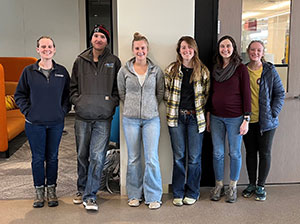
The Science Initiative (SI) Roadshow, a project of the University of Wyoming’s SI’s Learning Actively Mentoring Program and Wyoming Research Scholars Program, helped host a recent STEM Day at the Hanna, Elk Mountain, Medicine Bow (HEM) Junior/Senior High School.
This is the second year the roadshow team has participated in the STEM (science, technology, engineering and mathematics) Day at HEM.
On Feb. 17, the SI Roadshow collaborated with Kaitlyn Larson, a HEM Junior/Senior High School mathematics and science teacher, who invited Hanna Elementary School to participate in the STEM Day. Approximately 160 K-12 students participated in the event.
The SI Roadshow travels the state, bringing hands-on, interactive STEM lessons to K-12 classrooms, after-school programs and community groups. Teams of UW graduate and undergraduate students work collaboratively with K-12 teachers to design and implement curriculum that links with learning objectives and state standards in the classroom.
During the recent HEM event, K-12 students rotated through 10 different STEM stations. Students spent roughly 30 minutes at each station, exploring a topic in the sciences through hands-on activities. The roadshow team led seven stations, and the local Hanna FFA led three.
Karagh Brummond, director of UW’s SI Engagement and Outreach Program, headed the neuroscience room, where students learned about the different parts of the brain. Students observed actual animal brain specimens to determine how brain structure relates to behavior and function. After reviewing these concepts, students broke into small groups, where they worked together to design and draw a new animal of their choice.
“Based on the behaviors they wanted their animals to have in the wild, the students then sculpted the animals’ brains out of Play-Doh,” Brummond says.
Students learned about DNA and genetics with Katie Davis, a UW graduate student in the Program in Ecology from Frisco, Texas. The discussion centered on what DNA is and what it does. Students got their hands dirty by extracting DNA from strawberries. Using M&M candy as a model, the students then talked about the processes that can affect genetic diversity in populations and connected those processes to questions about endangered species and other conservation concerns.
To practice their engineering skills, students embarked on a design challenge led by Kathryn Sandum, a UW graduate student from New Boston, Mich., majoring in biomedical science. At the engineering station, students discussed what it means to engineer a project, including identifying a problem, planning a design and testing the prototype to make improvements. Students built bridges, cars, towers and airplanes from recycled materials. Their built structures and vehicles were tested against normal and “Wyoming-level” winds.
Students combined ideas of building and designing in a physics activity led by Liz Lungren, a UW undergraduate student from Ten Sleep majoring in molecular biology. After the groups of students were given a marble, tape and tubing, they put their knowledge of potential and kinetic energy to the test. Students were asked to demonstrate both types of energy through the construction of a creative, working roller coaster.
Students learned how static electricity is created during a session led by Lauren Kim, a UW graduate student from Rochester, N.Y., majoring in physics and astronomy. Students viewed a demonstration of the behavior of electrons, and Kim had the students play and experiment with a Van de Graaff generator. The generator demonstrated the ionization of air -- bright sparks and a snapping sound experienced when people receive an electric shock. To better understand the flow of charges, students used LED lights to figure out how to light up an LED using the generator.
Alyssa Baldwin, a UW graduate student in the Program in Ecology from Toledo, Ohio, headed a STEM room that focused on wetlands ecology. Students used paint pins covered in clay to form a makeshift slope and farmland and used sponges to denote wetlands. Students conducted experiments with and without the sponge, and they sprayed water on the clay slope and farmland. The students used laundry soap as a pollutant. When tested, the students could tell the sponges that represented wetlands collected that pollution. This experiment highlighted the importance of wetlands in the environment.
In the final roadshow lesson of the day, students learned about trees from Austin Bernard, a UW undergraduate student from Santa Cruz, Calif., majoring in engineering. To start, the students learned about the different parts of a tree cross-section. The discussion focused on the cambium cell layer, which is the growing part of the trunk. Students learned how new tree rings and cells are formed and their purpose in the tree. For example, the formed tree cells act as straws that carry water up to the canopy and, depending on the time of year, those cells would either be large or small.
Students modeled their own tree rings using the structures provided and various diameter straws. The model was used to show the wet and dry seasons in a tree ring as well as whether it was a wet or dry year. The students then looked at cross-sections of actual trees, identifying different sections of the tree and counting the rings.
Finally, the students observed some unique cases of tree cross-sections that had fire damage. That fire damage caused the cambium layer to stop producing new cells in that area. The surviving cambium grew cells that encompassed some of the dead tree parts, which resulted in a weird shape formation. The last tree cross-section had a small strip in a fire scar where the cambium layer was not killed. It grew a ball shape on top in between the fire scars.
For more information about the SI Roadshow, visit www.uwyo.edu/science-initiative/engagement.

